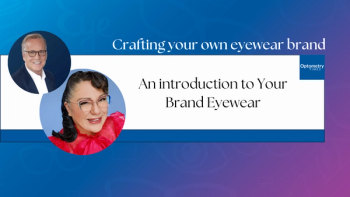
New technology helps IOP measurement
Not long ago, a colleague asked me if I performed Goldmann tonometry on all of my glaucoma patients. Without hesitation I said, “No.” When asked why not, I simply answered that not all of my patients are physically able to have the test performed on them.
Not long ago, a colleague asked me if I performed Goldmann tonometry on all of my glaucoma patients. Without hesitation I said, “No.” When asked why not, I simply answered that not all of my patients are physically able to have the test performed on them. For various reasons, some of our patients just can’t get positioned in the slit lamp.
This is the same reason why I do not perform threshold visual field studies on all of my glaucoma patients since some patients are either physically or cognitively (or both) unable to complete the test, let alone with any sense of tangible reliability. For example, I am reminded of a patient who comes in twice a year on a stretcher for me to check her diabetic retinopathy. I simply complete the entire examination with her lying down with a visual acuity chart, a penlight, an Icare tonometer, a binocular indirect ophthalmoscope, and a 20 D condensing lens.
More from Dr. Casella:
Tonometry-the standard of care
Goldmann applanation tonometry has long been the standard of care for measuring intraocular pressure (IOP) in patients with glaucoma (or glaucoma suspects). However, it is not without its limits (some more antiquated than others). Based on the research performed by Goldmann and Schmidt,1 a presumed central corneal thickness of 520 µm was decided upon for the Goldmann tonometer.
We know, of course, that central corneal thickness can have a clinically significant effect on “true” IOP in patients. I use the word “true” in quotation marks because direct IOP measurement involves invasion into the globe. Nonetheless, the notion that patients with thicker central corneas may tend to have lower IOPs as measured by Goldmann tonometry (and vice versa) prompted the circulation and use of correction tables in an attempt to calculate “true” IOP based on a linear relationship between Goldmann readings and central corneal thickness.
More from Dr. Casella:
The science behind this attempt to cope with the fact that the central cornea is almost never 520 µm thick, however, breaks down when one takes into account corneal hysteresis, notably the “squish factor.” The hallmark example of such would be a patient with Fuch’s endothelial corneal dystrophy, in which central corneal thickness could be up around 650 µm but in such a “squishy” cornea that IOP could end up being underestimated.
Dynamic contour and rebound tonometry
Dynamic contour tonometry (DCT) was developed about 20 years ago in an attempt to measure IOP without influence (or with minimal influence) from central corneal thickness or hysteresis.2 The Pascal (Ziemer) DCT tonometer does well employ the principles of DCT clinically. “Dynamic contour” is a clinically descriptive term which means there is little to no tangential force on the apex of the cornea, but instead type of contact in which the cornea is closer to its natural and tonic state during the measurement.2 In a perfect scenario, this would mean a truer measurement of IOP, and, indeed, Pascal has proven to be of benefit. The Pascal was designed to be used in conjunction with the slit lamp.3
More from Dr. Casella:
When I cannot perform Goldmann tonometry on a patient, for whatever reason, I use an Icare rebound tonometer, which consists of a probe that touches the central cornea and then rebounds at a certain rate of acceleration (or deceleration). The software within the instrument makes use of an algorithm to determine IOP based on values taken at the point of contact and rebound.
Correlation between Icare measurements and Goldmann measurements seems to be good, but not exact. That is not to say, however, that either is clinically better than the other because all methods of IOP measurement have their limits. We simply measure new technologies against our current gold standards. Needless to say, I am comfortable with the measurements I get when I am unable to perform Goldmann tonometry on a glaucoma patient. I also enjoy the fact that anesthetic is not needed for the Icare tonometer. This is especially helpful in my pediatric patients. I never thought I would be measuring IOP on babies, but I am now able to do just that.
More from Dr. Casella:
Standards of care are important both clinically and legally, as they dictate in no unclear terms how we are to care for our patients. That being said, they are just that: standards. Novel concepts, such as the Pascal and Icare tonometers, have the propensity to improve care where improvements are needed-be that ocular pulse amplitude measurements with the Pascal tonometer yielding information regarding blood flow or Icare measurements in pediatric populations and in patients who are impeded by sterics. More importantly, however, their advent helps to not only elevate the conversation regarding what direction standards of care should go but also keep the discussion going.
References
1. Goldmann H, Schmidt T. Uber applanations tonometrie. Ophthalmologica. 1957;134:221-242.
2. Kanngiesser HE, Nee M, Kniestedt C, et al. The theoretical foundations of dynamic contour tonometry. Poster presented at: The Annual Meeting of the Association for Research in Vision and Ophthalmology; May 6, 2003; Fort Lauderdale, FL.
3. Knecht PB, Bosch MM, et al. Dynamic contour tonometry: handheld versus slit-lamp-mounted. Ophthalmology. 2009 Aug;116(8):1450-4.
Newsletter
Want more insights like this? Subscribe to Optometry Times and get clinical pearls and practice tips delivered straight to your inbox.



















































.png)


